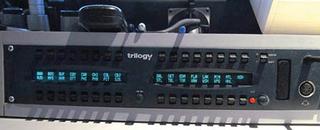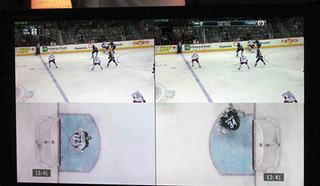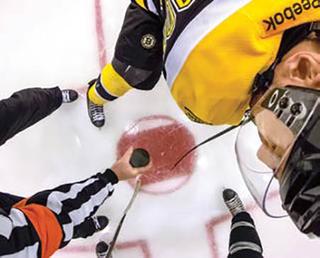Inside the NHL’s Situation Room

A partial view of the NHL Situation Room’s main video wall, showing the projection screen and some of the 46-inch monitors.
TORONTO—The White House has its Situation Room. The National Hockey League has one, too.
Unlike the White House version, the NHL Situation Room is solely concerned with hockey; specifically, live monitoring of all the plays taking place in up to 16 simultaneous NHL games/feeds across North America.
Whenever a goal is scored or a contentious scoring play occurs, the NHL Situation Room uses its in-house instant replay camera/server system to provide solid analysis fast. This analysis is immediately available to each game’s referees and goal judge via dedicated communication lines—including wireless communication devices worn by the refs.

The NHL Situation Room’s 32 key Trilogy Communications’ Gemini intercom.
“We provide the officials with reliable, technologically verified decision-making data,” said Mike Murphy, the senior vice president of hockey operations for the NHL. “The ref on the ice can speak with us directly, no matter which NHL arena he happens to be working in, and we can tell him what actually happened on a goal review situation.” Since it began operating in its current form in 2011, the Situation Room has reviewed literally hundreds of plays per season.

The four-screen view on the NHL game monitor’s computer screen, showing the two game feeds and both overhead goal camera views.
DISPLAY TECHNOLOGY
The NHL Situation Room is located in a 10th floor office inside a tower adjacent to Toronto’s Air Canada Center, in the heart of downtown.
Get the TV Tech Newsletter
The professional video industry's #1 source for news, trends and product and tech information. Sign up below.
The room itself measures about 20x40 square feet in size. Walk in, and the first thing you see is the front wall HD video display along one of the walls. The overhead projector-driven central screen measures nearly 7 feet diagonally, and can be split to show 16 separate video windows. Since there are 30 teams in the NHL, this means that the central screen can show all 15 games at once, with one video window to spare. For those times when the screen has been expanded to just four video windows, extra feeds can be seen on the 12 46-inch HD monitors that flank the central display; six on each side. (Each of the 46-inch screens can be quartered electronically to show four video windows apiece.)
Looking towards this screen is “The Bridge,” the room’s length-wise control center, where the day’s game managers stay in close contact with game officials. This is where Mike Murphy and his key people sit when the games are on; eyes glued to the TVs, and watching the overhead red strobe lights that flash whenever a call is coming in from a game. (There’s too much going on in the NHL Situation Room to rely on audio telephone alerts.)
Around The Bridge are 16 dedicated multimonitor viewing workstations. Powered by a custom-made NeuLion instant replay video platform, each workstation is configured to provide multi-angle views of just one hockey game. This is why the room has 16 workstations; enough for all 15 possible games plus a backup.
“This is where our people see what is happening on the ice, and monitor all aspects of the game, with the main responsibility being to initiate the video review process,” said Rod Pasma, senior director of hockey operations for the NHL.
SYNCHRONIZED FEEDS
Each NHL Situation Room workstation is equipped with four 24-inch HD monitors. The first screen on the left shows the game as distributed on a satellite TV feed. The next two screens show real-time feeds direct from the arena’s on-site broadcasters (home and away) via fiber-optic cable. Thanks to satellite latency, it is common for the satellite feed to be up to 15 seconds behind the live feed.
The fourth HD screen on the right, with its screen split into four video windows, is the one that really matters. Using feeds synchronized off-site by NeuLion in New York—and fed to Toronto via fiber-optic cable—the top two windows show the two broadcast arena fiber-optic feeds. The lower two windows show the goal zones at both ends, using either an operator- selected above-net or in-goal camera. (These cameras belong to the NHL, and their feeds are only shown on air if the NHL decides to release the footage to the broadcasters.)
GoPro Gives New Perspective on NHL
Hockey fans were given the chance to watch the annual National Hockey League All-Star Game last month up close and personal because of a partnership between the NHL and POV camera maker GoPro.

The agreement is GoPro’s first with a major professional sports league and is designed to promote the company’s new Professional Broadcast Solution, developed with Vislink. The partnership gives the NHL the right to use GoPro cameras and transmission equipment during its regular season, to give hockey fans never-before-seen perspectives of the game, starting with the NHL All-Star Game in Columbus, Ohio the weekend of Jan. 23-25. As part of the deal, GoPro will receive prominent brand exposure across NHL’s broadcast, digital and social media platforms.
“Together we will push the boundaries of video content production in hockey and provide fans of the sport with unique, immersive perspectives of the game they’ve never seen before,” said Todd Ballard, senior director of Lifestyle Marketing for GoPro.
“The four NeuLion feeds are totally synchronized, and can be toggled frameby- frame,” said Pasma. “This means that the workstation operator can see how the goal went in from multiple angles. Having so many views eliminates blind spots, and ensures that our people can make accurate goal decisions quickly—which is critical to the flow of the game, and its credibility with the fans.”
Murphy was non-committal when asked if the NHL is considering using 4K to improve picture resolution for instant replay. “We will consider every piece of equipment or technology advancement to help us make the correct call,” he said.
MAKING A DIFFERENCE
Having access to such a sophisticated and reliable instant-replay system has allowed the NHL to up its officiating game. “For instance, once during an Ottawa Senators- LA Kings shoot-out a goal was scored during overtime, but no one at the arena saw the shot due to the angle and state of play,” Murphy said. “Overtime was about to resume when we alerted the referees and the goal judges that yes, the puck did go into the net and the game was over!”
Such is the success of the NHL Situation Room in improving officiating, that the NFL has stopped by to see the layout, and consider a similar monitoring solution for professional football. That said, the more fluid nature of NFL (versus NHL) play could make it harder to achieve the same level of reliability in pro ball.Murphy isn’t worried about this. His focus is on making NHL officiating as accurate as possible, and with the help of the NHL Situation Room, “we are making it happen,” he said.
James Careless is an award-winning journalist who has written for TV Technology since the 1990s. He has covered HDTV from the days of the six competing HDTV formats that led to the 1993 Grand Alliance, and onwards through ATSC 3.0 and OTT. He also writes for Radio World, along with other publications in aerospace, defense, public safety, streaming media, plus the amusement park industry for something different.

